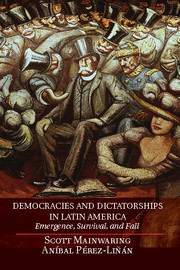Book contents
- Frontmatter
- Dedication
- Contents
- List of Tables
- List of Figures
- Acknowledgments
- 1 Introduction
- 2 A Theory of Regime Survival and Fall
- 3 Competitive Regimes and Authoritarianism in Latin America
- 4 Regime Survival and Fall
- 5 From Multiple Breakdowns to Stabilization of Democracy: Argentina
- 6 From Persistent Authoritarianism to a Durable Democracy: El Salvador
- 7 International Actors, International Influences, and Regime Outcomes
- 8 Political Regimes after the Third Wave
- 9 Rethinking Theories of Democratization in Latin America and Beyond
- Appendix 3.1 Coding Rules for Political Regimes
- Appendix 3.2 Coding U.S. Foreign Policy toward Democracy in Latin America
- Appendix 4.1 Long-Run Equilibrium for the Proportion of Competitive Regimes
- Appendix 5.1 Qualitative Comparative Analysis
- Appendix 6.1 Coding of Salvadoran Actors, 1979–2010
- Bibliography
- Index
Appendix 3.2 - Coding U.S. Foreign Policy toward Democracy in Latin America
Published online by Cambridge University Press: 05 June 2014
- Frontmatter
- Dedication
- Contents
- List of Tables
- List of Figures
- Acknowledgments
- 1 Introduction
- 2 A Theory of Regime Survival and Fall
- 3 Competitive Regimes and Authoritarianism in Latin America
- 4 Regime Survival and Fall
- 5 From Multiple Breakdowns to Stabilization of Democracy: Argentina
- 6 From Persistent Authoritarianism to a Durable Democracy: El Salvador
- 7 International Actors, International Influences, and Regime Outcomes
- 8 Political Regimes after the Third Wave
- 9 Rethinking Theories of Democratization in Latin America and Beyond
- Appendix 3.1 Coding Rules for Political Regimes
- Appendix 3.2 Coding U.S. Foreign Policy toward Democracy in Latin America
- Appendix 4.1 Long-Run Equilibrium for the Proportion of Competitive Regimes
- Appendix 5.1 Qualitative Comparative Analysis
- Appendix 6.1 Coding of Salvadoran Actors, 1979–2010
- Bibliography
- Index
Summary
Using secondary sources, we coded each presidential term in the United States on eight questions, presented in Table A3.2. These questions focus specifically on U.S. government behavior regarding political regimes in Latin America. We did not code other aspects of U.S. government policy that might affect Latin America – for example, economic policy – or the role of U.S. companies, human rights organizations, or interest associations in the region. The index varies on a yearly basis, although U.S. administrations tend to have consistent scores over time. Policy shifts occurred for at least one of the eight questions during the presidencies of Woodrow Wilson, Franklin Roosevelt, Harry Truman, Dwight Eisenhower, John Kennedy, and Ronald Reagan.
Two individuals coded all administrations; no question presented problems of inter-coder reliability. Our aggregation rule was simple. We added each administration’s score for the eight questions, producing a scale ranging from –4 to 4. We then rescaled the total score to range between 0 and 1, using the formula: US Policy = (4 + Σ Qk)/8 where Qk represents the score for the k-th question coded.
- Type
- Chapter
- Information
- Democracies and Dictatorships in Latin AmericaEmergence, Survival, and Fall, pp. 300 - 302Publisher: Cambridge University PressPrint publication year: 2014



